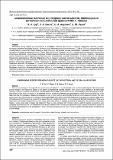| dc.contributor.author | Тур, Элина Аркадьевна | |
| dc.contributor.author | Басов, Сергей Владимирович | |
| dc.contributor.author | Акулова, Ольга Александровна | |
| dc.contributor.author | Русак, Екатерина Юрьевна | |
| dc.coverage.spatial | Брест | ru_RU |
| dc.date.accessioned | 2024-05-31T09:47:19Z | |
| dc.date.available | 2024-05-31T09:47:19Z | |
| dc.date.issued | 2024 | |
| dc.identifier.citation | Тур, Э. А. Комплексные научные исследования объектов, являющихся историко-культурными ценностями г. Пинска / Э. А. Тур, С. В. Басов, О. А. Акулова, Е. Ю. Русак // Вестник Брестского государственного технического университета. – 2024. – № 1 (133). – С. 28–33. | ru_RU |
| dc.identifier.uri | https://rep.bstu.by/handle/data/43361 | |
| dc.description.abstract | Важнейшей частью проекта по реконструкции и реставрации объектов, включенных в Перечень недвижимых объектов историко-культурного наследия Республики Беларусь, является раздел «Комплексные научные изыскания». С 2006 по 2023 годы учеными Брестского государственного университета были проведены многочисленные комплексные научные исследования недвижимых объектов историко-культурного наследия (исторических зданий) г. Пинска Брестской области. В данной статье был проведен анализ исследованных аутентичных строительных растворов и аутентичных окрасочных составов двадцати объектов. Было определено, что русты, пилястры и венчающие
карнизы большинства зданий первоначально были окрашены минеральными составами белого цвета. Основные плоскости стен фасадов большинства анализируемых объектов первоначально были окрашены составами, имеющими бежевую и желтовато-бежевую цветовую гамму (14 зданий из 20-ти анализируемых). В результате проведенного анализа определены основные тенденции формирования цветового решения исторической застройки г. Пинска. К сожалению, во времена Советского Союза ремонт фасадов проводился регулярно, но без проведения каких-либо обследований, и состоял в расчистке фасада в местах отслоения краски или штукатурного покрытия. Таким образом, на многих значимых и представляющих интерес объектах, аутентичные окрасочные составы были полностью безвозвратно утрачены. Внедрение результатов научно-исследовательской работы в проектирование и производство позволило обеспечить принятие научно-обоснованных решений при разработке проектно-сметной документации и проведении всех видов работ на конкретных недвижимых объектах
историко-культурного наследия. | ru_RU |
| dc.language.iso | ru | ru_RU |
| dc.publisher | БрГТУ | ru_RU |
| dc.subject | комплексные научные исследования | ru_RU |
| dc.subject | историко-культурное наследие | ru_RU |
| dc.subject | аутентичные окрасочные составы | ru_RU |
| dc.subject | comprehensive scientific research | ru_RU |
| dc.subject | historical and cultural heritage | ru_RU |
| dc.subject | authentic paint compositions | ru_RU |
| dc.title | Комплексные научные исследования объектов, являющихся историко-культурными ценностями г. Пинска | ru_RU |
| dc.title.alternative | Comprehensive scientific research of objects that are historical and cultural values of Pinsk | ru_RU |
| dc.type | Статья (Article) | ru_RU |
| dc.identifier.udc | 72.025.4(476.7) | ru_RU |
| dc.abstract.alternative | The most important part of the project for the reconstruction and restoration of objects included in the List of immovable objects of the historical and cultural heritage of the Republic of Belarus is the section "Comprehensive scientific research." From 2006 to 2023, scientists of the Brest State University conducted numerous comprehensive scientific studies of immovable objects of historical and cultural heritage (historical buildings) of Pinsk, Brest Region. In this article, an analysis of the examined authentic mortars and authentic paint compositions of twenty objects was carried out. It was
determined that the rustications, pilasters and crowning cornices of most buildings were originally painted with white mineral compounds. The main planes of the walls of the facades of the majority of the analyzed objects were initially painted with compounds having beige and yellowish-beige colors (14 buildings out of 20 analyzed). As a result of the analysis, the main trends in the formation of color schemes for the historical buildings of Pinsk were determined. Unfortunately, during the Soviet Union, facade repairs were carried out regularly, but without any inspections, and consisted of clearing the facade in places where paint or plaster had peeled off. Thus, on many significant and interesting objects, authentic painting compositions were
completely and irretrievably lost. The introduction of the results of research work into design and production made it possible to ensure the adoption of scientifically based decisions in the development of design estimates and carrying out all types of work on specific immovable objects of historical and cultural heritage. | ru_RU |
